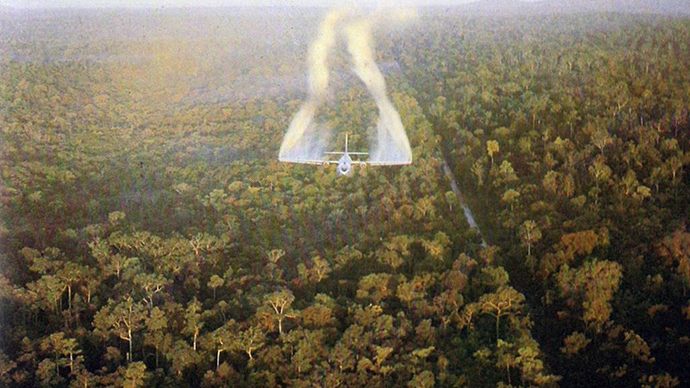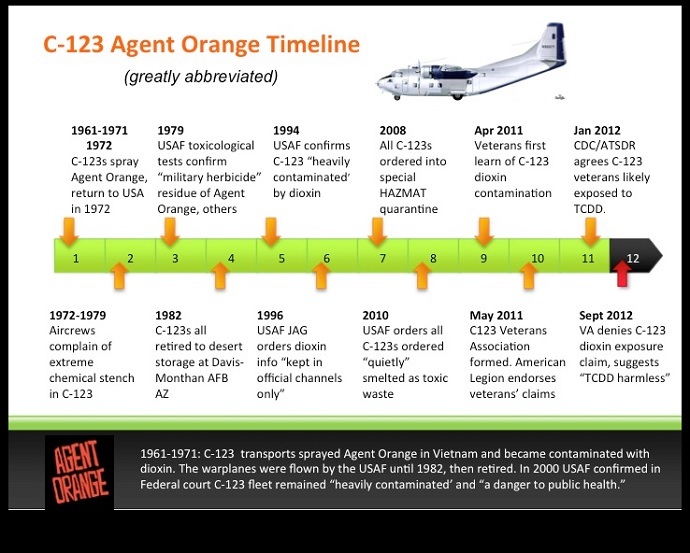Agent Orange victims in Air Force Reserve now eligible for compensation

Air Force vets and reservists who were exposed to the toxic Agent Orange herbicide during and after the Vietnam War are now eligible for federal compensation for their related illnesses and disabilities, the Department of Veterans Affairs (VA) announced.
The VA published a new regulation Thursday, expanding eligibility for benefits related to Agent Orange exposure to “a select group of Air Force Veterans and Air Force Reserve personnel” who were exposed to the cancer-causing herbicide “through regular and repeated contact with contaminated C-123 aircraft that had been used in Vietnam as part of Operation Ranch Hand (ORH).”
Secretary of Veterans Affairs Robert A. McDonald made the decision to expand benefits following a 2015 report by the National Academy of Sciences’ Institute of Medicine (IOM), commissioned by the department, on Agent Orange exposure in C-123 aircraft. The report found evidence that as many as 1,500 to 2,100 Air Force and Air Force Reserve personnel who served as flight, medical and ground maintenance crew members on ORH C-123 aircraft that had previously been used to spray Agent Orange in Vietnam were exposed to the dangerous herbicide.
READ MORE: VA hit with class action lawsuit from Vietnam vet over disability benefits
“Opening up eligibility for this deserving group of Air Force veterans and reservists is the right thing to do,” McDonald said in a statement. “We thank the IOM for its thorough review that provided the supporting evidence needed to ensure we can now fully compensate any former crew member who develops an Agent Orange-related disability.”
The rule presumes that those Air Force and Air Force Reserve members who served on the contaminated ORH C-123s were exposed to herbicides during their service, thus making it easier for them to establish entitlement for some VA benefits if they develop an Agent Orange-related presumptive condition, the department said.
It also presumes that Agent Orange-related conditions for affected Air Force Reserve crew members began during their Reserve training, “thus establishing that this service constituted ‘active, naval, military or air service’,” the VA said in its interim final rule filed with the Federal Register.
The rule ensures that those reservists are eligible for VA disability compensation and medical care for any Agent Orange-related presumptive condition, and that their surviving dependents are eligible for dependency and indemnity compensation and burial benefits, the VA said in its statement.
Retired Air Force Maj. Wes Carter, a former C-123 officer, told the Military Times that the VA decision ‒ an about-face decades in the making ‒ is "a relief" that is unfortunately "tempered by the grief felt for lost comrades."

Carter, who has prostate and bladder cancer, led the fight for benefits through the C-123 Veterans Association, though he already receives VA benefits from an unrelated disability stemming from the 1991 Persian Gulf War, the Pittsburgh Post-Gazette reported.
Sen. Sherrod Brown of Ohio ‒ one of three Democrats, along with Jeff Merkley and Ron Wyden of Oregon, who placed a hold on President Barack Obama’s nominee for the top health post at the embattled VA ‒ praised the department’s decision.
"These veterans and their families have waited too long to receive benefits that they earned," Brown said in a joint statement.
For Carter, however, the struggle for his fellow service members isn’t over.
"Every medical and scientific fact that convinced the Institute of Medicine of our Agent Orange exposures in 2014 had been presented to the VA years earlier but was ignored. This is wrong," Carter wrote in an email to the Military Times. "We ask Secretary McDonald and [Under Secretary Allison] Hickey for their careful review of VA actions to insure that toxic exposure veterans never again face such an unhappy struggle."
In 2014, the VA requested that the IOM conduct a consensus study on residual exposure to Agent Orange from service on aircraft formerly used during Operation Ranch Hand in Vietnam. Specifically, the VA requested that the IOM “determine whether there had been exposures that could lead to excess risk of adverse health outcomes among [Air Force] Reserve personnel who flew in and/or maintained C-123 aircraft (outside of Vietnam) that had previously been used to spray Agent Orange.”
The IOM’s report, published in 2015, found that, from 1972 to 1982, approximately 1,500 to 2,100 Air Force Reserve personnel trained and worked on the approximately 30 C-123 aircraft that had been used to spray herbicides in Vietnam, and those crew members had regular and repeated contact with those 30 aircraft.
The report identified the specific aircraft and the Reserve units to which the C-123s were assigned, and concluded, “It is probable that the [herbicide] exposures of at least some [Air Force] Reservists exceeded levels equivalent to some guidelines established for office workers in enclosed settings.” The IOM determined that it is “plausible that the C-123s did contribute to some adverse health consequences among [Air Force] Reservists who worked in [Operation Ranch Hand] C-123s after the planes returned from Vietnam.”

Those 1,500 to 2,100 Air Force Reserve personnel are the ones who are eligible for benefits under the new rule. It’s the first time the VA has established a special category of Agent Orange exposure for service members who did not serve in Vietnam, AP reported. Nearly 200,000 veterans who served off the coast of Vietnam ‒ so-called “Blue Water” service members ‒ remain ineligible for exposure benefits.
While the new rule is beneficial for the affected veterans, it could create more problems for the VA and other veterans whose cases remain backlogged. The number of VA claims skyrocketed under President Barack Obama after the administration previously enacted new rules that permitted more Agent Orange claims, as well as loosened restrictions for veterans who returned from Iraq or Afghanistan.
READ MORE: Too little too late? US to clean up Agent Orange in Vietnam
The rule also does nothing for Vietnamese citizens who were affected by the poison, or the following generations that are still dealing with the consequences. While the US government has acknowledged a connection between Agent Orange and the 15 illnesses and 18 birth defects that continue to plague the lives of American Vietnam vets and their families, the US has refused to make the same link for the millions of Vietnamese War victims whose lives have been devastated as a result of Agent Orange.
Previous recipients of payments due to Agent Orange exposure include two former US service members who were stationed at Futenma Air Base on Okinawa Island during Vietnam, which was a forward staging post for the US military during the war. The VA awarded the two men compensation in February 2012.
Meanwhile, Monsanto ‒ the company that produced dioxin, the noxious, cancer-causing byproduct of the herbicide ‒ agreed in 2012 to compensate residents of the West Virginia town where its Agent Orange plant was located. Under the settlement, Monsanto consented to pay $84 million for a 30-year monitoring program in Nitro, West Virginia and $9 million towards property clean-up efforts in still-contaminated cities.
The VA will immediately begin processing claims and issuing benefits to eligible Air Force crew members.












